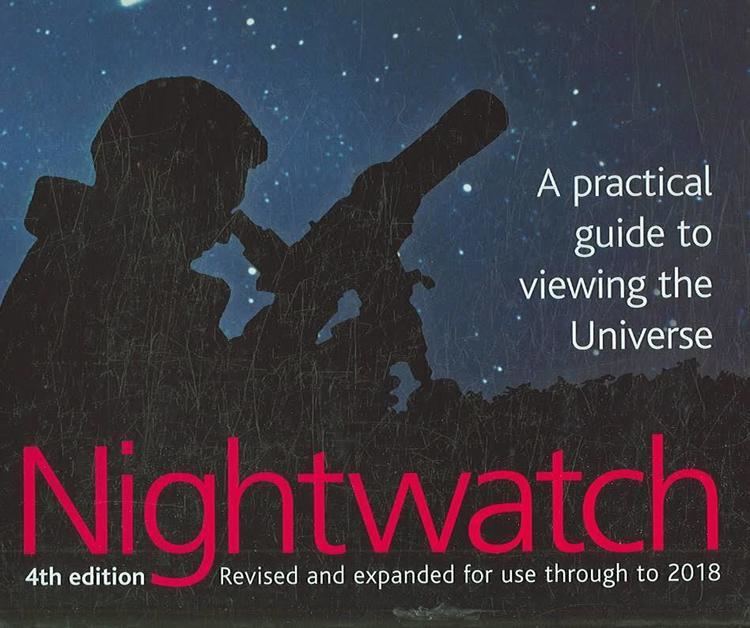8.6 /10 1 Votes
Country United States Publication date September 2005 Pages 192 Genre Popular science | 4.3/5 Goodreads Publisher Firefly Books Ltd. Media type Print Originally published September 2005 Page count 192 Subject Astronomy | |||||||||||||||||||||||||||||||||
 | ||||||||||||||||||||||||||||||||||
Illustrator Adolf Schaller, Victor Constanzo, Roberta Cooke, Glenn LeDrew Similar Works by Terence Dickinson, Other books | ||||||||||||||||||||||||||||||||||
Nightwatch a practical guide to viewing the universe by terence dickinson
NightWatch: A Practical Guide to Viewing the Universe [1] is a best-selling popular science book by Terence Dickinson. NightWatch is widely regarded as the essential guidebook for beginning stargazers. First published in 1983, there are over 800,000 copies in print, making it the top-selling stargazing guide in the world during the past 20 years. A fifth edition is expected in 2013. Each new edition has outsold the previous one because of revisions, updated material, star charts in particular, and new information on telescope and binocular technology. For the first time, the latest edition includes star charts for the Southern Hemisphere. There are also tables of future solar and lunar eclipses, planetary conjunctions and planet locations, all current to 2018. Over time, Dickinson has polished the book’s format and improved its usability based on his experience and comments from his colleagues, readers and fans.
Contents
- Nightwatch a practical guide to viewing the universe by terence dickinson
- Holiday gift guide pick nightwatch a practical guide to viewing the universe video
- Summary
- Foreword
- Discovering the Cosmos
- The Universe in Eleven Steps
- Backyard Astronomy
- Stars for all Seasons
- Stargazing Equipment
- Probing the Depths
- The Planets
- The Moon and Sun
- Solar Eclipses and Lunar Eclipses
- Comets Meteors and Auroras
- Photographing the Night Sky
- Southern Hemisphere
- References
NightWatch owes its success in large part to Terence Dickinson's ability to simplify astronomical concepts and explain the universe in easily understood terms, giving would-be stargazers and naturalists a new appreciation for the wonders of the universe. From its first publication, NightWatch has been widely considered the essential star-watching guide for amateur astronomers of all levels of experience. Over its 30-year life and with each new edition, reviews by newspapers, magazines, and science and astronomy journals have been consistently enthusiastic.
This latest edition contains dozens of new photographs, which show the latest and most important discoveries made by current space observatories and probes.
Holiday gift guide pick nightwatch a practical guide to viewing the universe video
Summary
The aim of NightWatch is to impart knowledge of the Universe and how to observe it in a ready-friendly manner and assuming no prior experience with astronomy. The book's thirteen chapters are heavily illustrated with photographs, illustrations, diagrams and star charts.
Foreword
Terence Dickinson describes NightWatch as “a star-gazing companion that awakens, informs and keeps you reading.”
Discovering the Cosmos
This chapter asks the reader to consider our place in the vast universe and the “limitless hunting ground” that awaits all who care to take up a pair of binoculars or a telescope.
The Universe in Eleven Steps
Explains the Milky Way Galaxy in 11 steps beginning with Earth, the moon and the solar system, and then farther and farther away in distance and time to the Hubble Deep Field and the end of the universe.
Backyard Astronomy
A primer on how to observe the sky with the unaided eye. Sky motion, sky measures, star brightness, the constellations, star names, comets and meteors. Includes a pronunciation guide for stars and constellations.
Stars for all Seasons
Information on sky watching in all seasons, plus sky photos and star charts. There is also information on light pollution, the Ecliptic and the Zodiac plus reality checks of the urban myths of stargazing.
Stargazing Equipment
Comprehensive information on binoculars and telescopes, making the right choice, recommended models, comparisons and how to use. Computer-age scopes, accessories, eyepieces.
Probing the Depths
Describes double stars, variable star, star clusters, nebulas, globular clusters, and galaxies. Explains how astronomers determine the distances to stars and galaxies, how sky objects are designated, and how to use deep-sky charts. Includes an atlas of 20 star charts. The charts are ideal for stargazers using a small telescope or binoculars.
The Planets
The visible planets: Mercury, Venus, Mars, Asteroid Belt, Jupiter, Saturn, the Outer Planets, Visibility of Planets 2005-2018.
The Moon and Sun
Moon Maps, Observing the Sun, The Moon Illusion
Solar Eclipses and Lunar Eclipses
Observing eclipses, the eclipse cult and eclipse tables.
Comets, Meteors and Auroras
Includes famous and infamous comets, the information carried in meteors, and the science of auroras.
Photographing the Night Sky
Digital technology for astronomy continues to evolve at a rapid pace. Here, Dickinson explains the astro-imaging revolution, night-sky digital imaging techniques, the Barn door tracker, CCD cameras and computerized telescopes. Dickinson also explains how to use a digital camera without a telescope to take night sky photographs.
Southern Hemisphere
New to NightWatch, this edition covers skywatching on the Southern Hemisphere, including the Caribbean Night Sky.
